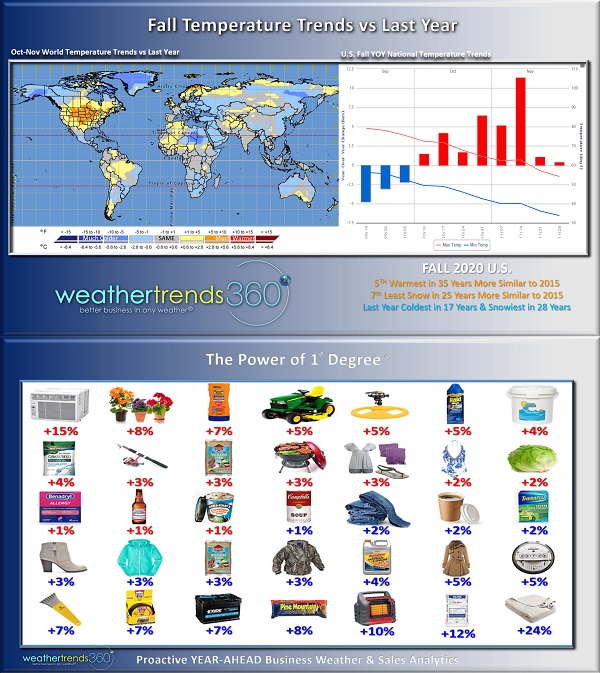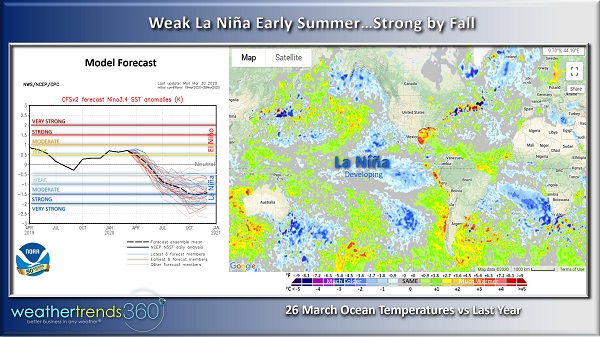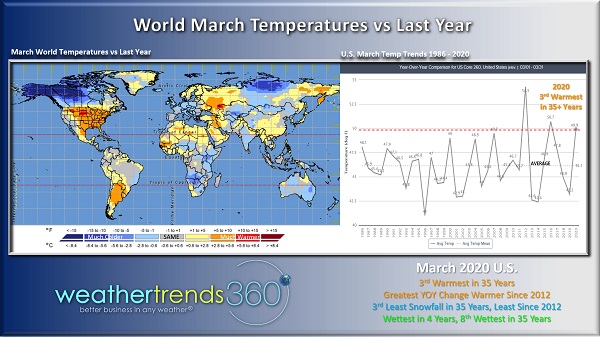The 2020 Fall Weather Outlook
COVID-19
The global impact on both lives and the economy will be historic indeed. The economic losses for all but a few big e-commerce and grocery retailers (Wal-Mart, Amazon, Costco, Kroger) will be in the trillions of dollars. Many small businesses and even larger mall-based retailers may not survive with millions in the U.S. under "stay at home" orders and very likely over a billion around the world in similar situations. But there is light at the end of the tunnel as COVID-19 is a SARS-like virus and in 2003 SARS flared up with similar trends to COVID-19 but then never really came back. No one knows for sure why, but as humans we have the benefit of "herd immunity." SARS as a model shows the peak occurred in April 2003 and then faded away with warmer, humid and sunny weather. Flu and weather research shows warmer, humid and sunny (high UV) weather conditions are a significant factor in the longevity and spread of flu-type illness.
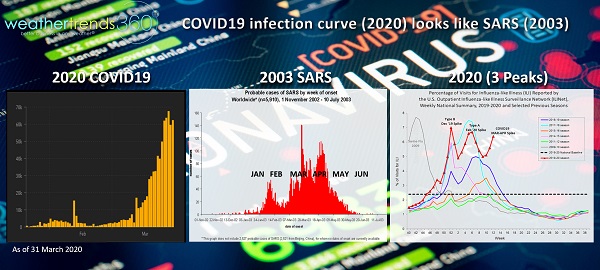
Research from the Spanish Flu pandemic, when 20-75 million died globally, showed that patients treated outside of hospitals with exposure to the sun and fresh air had much higher survival rates in part due to FRESH AIR and UV (natural Vitamin D). https://medium.com/@ra.hobday/coronavirus-and-the-sun-a-lesson-from-the-1918-influenza-pandemic-509151dc8065
Harvard research on Flu also showed that higher temperatures and humidity ultimately diminished the spread of viruses in rats. Another reason Flu flares up in the colder winter months is the result of weaker immune systems due, in part, to lower Vitamin D levels with weaker sun intensity. http://sitn.hms.harvard.edu/flash/2014/the-reason-for-the-season-why-flu-strikes-in-winter/
Did you know? "Influenza" comes from the Italian name "influenza di freddo", meaning "influence of the cold." With the cold referencing the WEATHER!
Weather Trends has analyzed many data sets that may prove very valuable as we enter the 2020 - 2021 Flu, cough and cold season. We have correlated 17 years of CDC Flu data to weather and can project when the season will start, peak and end by zip code across the U.S. and how this differs from last year. In addition, we have analyzed decades of EPA daily pollution data and can project the weekly periods a year-ahead across every zip code that will have high pollution levels which exacerbate upper respiratory illnesses and even plays a role in the severity of COVID-19 complications. Finally, we can project a 10-point Asthma suffering index by zip code by week, OUT A YEAR across the U.S. and soon worldwide. Call or email sales@weathertrends360.com for more information.
FALL 2020 OUTLOOK
Weather Trends year-ahead long-range outlook for Fall 2020 shows a lot of risk for struggling retailers but also some good news! Fall in 2019 brought the coldest weather in 17 years and snowiest in 28 years to the U.S. which was a huge benefit to cold Fall seasonal merchandise. It also allowed Flu type B to get off to a very fast start resulting in one of the biggest and earliest spikes in Flu by Christmas with the entire country having widespread flu per the CDC. The good news about Weather Trends' Fall 2020 outlook is that the flu season ahead will be delayed by as much as 5 weeks with a later peak in February due to much warmer and drier/less snowy weather. October and November overall look to trend the warmest in 3 years with a top 5 warmest Fall in 35 years for the U.S. as a whole. Fall trends more similar to 2015 which was very warm coming off a very cold/snowy Fall in 2014.
The bad news for retailers will be double-digit declines in seasonal merchandise sales for categories like apparel, shoes, snow removal, pantry loading food items, etc. The other very big negative is the potential for a catastrophic Atlantic hurricane season with potential major damage risk to the Caribbean, Florida and the Northeast U.S. There are many climate cycles with La Niña just one of 24 that we factor in along with trillions upon trillions of our statistics that all point to a devastating high-risk season.
Our year-ahead outlook shows at least 20 named storms but the more important factor is the high-risk Northeast, first time in 8 years we've highlighted this area. Weather Trends will issue our final client report in middle April which may increase the risk for the North Central Gulf of Mexico as well. A devastating season in the making for the U.S.!
Our Power of 1 Degree technology has quantified the influence of weather on over 10,000 seasonal categories based on real POS data, let's talk about what it means for your seasonal items. We can both quantify how the weather has helped or hurt your sales, but then predict those sales a year-ahead by week by store everywhere on Earth.
AMAZON MARKET PLACE & WT360
Weather Trends partnered with Amazon's AWS Marketplace in the Fall of 2019 and now has 52 on-line historical, short and long range year-ahead data sets and forecasts. These can be purchased instantly by visiting: https://aws.amazon.com/marketplace/seller-profile?id=f029d725-a004-445e-99c1-8657cda8982d
We are in the process of adding many other long range YEAR-AHEAD forecasts of weather and seasonal sales forecasts on the Market Place.
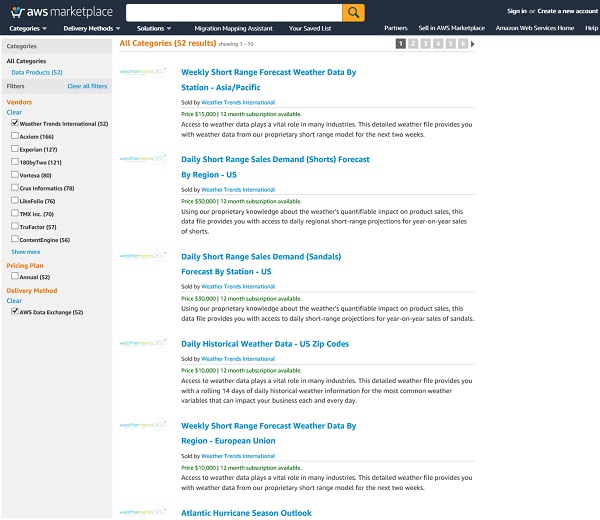
MARCH 2020 RECAP
As expected, March 2020 was nearly off the charts in terms of much warmer and much less snowy weather. Our year-ahead outlook was on our home page back in September highlighting this big change. But even in middle to late February, NOAA and short-range physics-based models were predicting another cold/snowy March... THAT DID NOT HAPPEN! The U.S. overall had the 3rd warmest March in 35 years with the greatest change in year-over-year temperatures since 2012 and snowfall was the 3rd least in 35 years and the least since 2012. 2012 was the hottest March on record for the U.S. dating back 124 years. Rainfall was still above average trending 8th wettest in 35 years and wettest in 4 years. Ordinarily these would have brought exceptional sales gains for seasonal merchandise sales, but COVID-19 obviously was a huge negative for all but essential merchandise.
Weather Trends year-ahead forecasts are off to a good start in 2020 trending 84% accurate on weekly temperatures, 80.2% on daily year-ahead temperatures and 91.7% on weekly year-ahead precipitation trends. All of this is much more accurate than a short range 7-14 day forecast by many degrees!
FEATURED CLIENT TESTIMONIAL
Everyone starts out a skeptic when it comes to YEAR-AHEAD weather and sales forecasting, we get it, but it doesn't take long to see the immense value our solutions offer so many industries in retail, supply, financial service, pharma and agriculture. Noah Freeman, from AgReliant Genetics, talks about how he went from skeptic to believer in short order and now 6 years later helped thousands of their farmer customers to become PROACTIVE not REACTIVE to the weather ahead. Video below and white paper link here. For more on our FarmCast® solutions please visit https://www.weathertrends360.com/Agriculture-Weather-Analytics
Stay safe and healthy!
